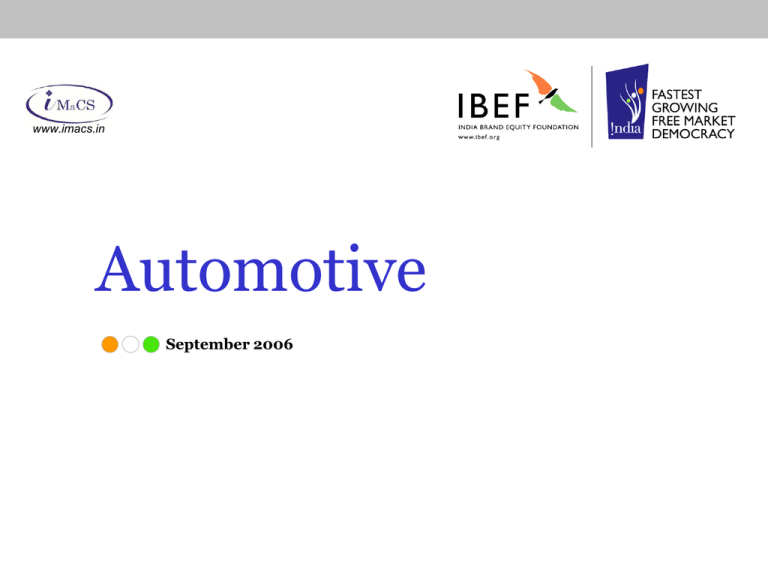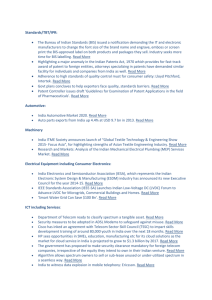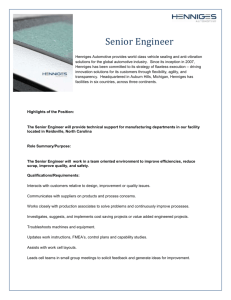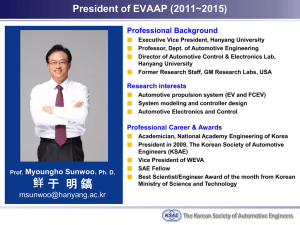
www.imacs.in
Automotive
September 2006
www.imacs.in
Contents
• Market Overview
• Government regulations & policy
• India Advantage
and business opportunities
AUTOMOTIVE
www.imacs.in
Market
Overview
• Market Overview
• Government regulations & policy
• India Advantage and business opportunities
AUTOMOTIVE
www.imacs.in
AUTOMOTIVE
Market Overview
Profile: Indian Automotive Industry
• The industry has grown at a CAGR of 14% p.a over the last 5 years,
with sales of 9 million vehicles in 2005-06
• With the potential to emerge as one of the largest in the world. Presently, India is
• 2nd largest two wheeler market in the world
• 4th largest commercial vehicle market in the world
• 11th largest passenger car in the world and is expected to be the 7th largest market by 2016
• The industry has emerged as a key contributor to the Indian economy
Vehicle sales in India in 2005 - 06 ( in mil)
Size of around
US$ 34 billion
in 2006
0.36
7.05
0.35
1.14
0
2
Cars
Source : SIAM
4
CVs
Two wheelers
6
Three Wheelers
8
www.imacs.in
AUTOMOTIVE
Market Overview
Auto components industry has
also grown at a rapid pace ...
• The Indian auto components
Size of Component Industry (US$ mn)
10000
8700
17%
6730
3849
3965
FY00
FY01
Source : ACMA
4470
FY02
• Market breakup: OEM demand
5430
FY03
industry has grown at 17%
CAGR over the last few years
to reach a size of around
US$ 10 billion in 2005-06
~ 54%, replacement market
~30%, exports ~16%
FY04
FY05
FY 06
FY refers to Financial Year – April to March
www.imacs.in
AUTOMOTIVE
Market Overview
Players: Indian auto industry
•
•
•
•
•
•
•
•
•
GM
Toyota
Ford
Hyundai
Maruti Suzuki
Honda
Skoda
Volvo
Mercedes
•
•
•
•
•
•
Delphi
Visteon
Bosch
Denso
Valeo
Thyssen Krupp
Indian
Auto
Industry
Global
OEM
Indian
OEM
Global
Suppliers
Indian
Suppliers
Engineering &
Development
Companies
The Indian auto industry is highly competitive
with a number of global and Indian auto companies present
•
•
•
•
•
•
•
Tata Motors
Mahindra & Mahindra
Bajaj Auto
TVS Motors
Hero Honda
Bajaj Tempo
Ashok Leyland
•
•
•
•
•
•
Bharat Forge
Sundram Fasteners
Rane Group
Shriram Pistons
RICO Auto
Sono Koyo Steering
www.imacs.in
AUTOMOTIVE
Market Overview
Automotive clusters in India
Delhi-Gurgaon-NoidaGhaziabad
Ludhiana
Haridwar
Pitampur
Jamshedpur
Rajkot-Halol
Mumbai-Pune-Nasik
Aurangabad
Kolkata
Hyderabad
Chennai Bangalore Hosur
Source: SIAM, IMaCS analysis
North / Central
South
Ashok Leyland
Force Motors
Hindustan Motors
Honda SIEL
Kinetic
Majestic
Piaggio
Swaraj Mazda
Ashok Leyland
Ford
Hindustan Motors
Mahindra & Mahindra
Toyota Kirloskar
Volvo
Eicher
Hero Honda
Honda
ICML
LML
Maruti Suzuki
Yamaha
Tata Motors
East
West
Hindustan Motors
Tata Motors
Ashok Leyland
Bajaj Auto
FIAT
GM Greaves
M&M
Skoda
Enfield
Greaves
Hyundai
Tatra
TVS Motors
Atul Auto
Daimler Chrysler
Force Motors
Kinetic
Premier
Tata Motors
Major automotive clusters - Mumbai-Pune-NasikAurangabad (West), Chennai -Bangalore-Hosur (South) and
Delhi-Gurgaon-Faridabad (North)
www.imacs.in
AUTOMOTIVE
Market Overview
Exports are rising - India has the potential
to become the global outsourcing hub
600000
60
500000
50
400000
40
300000
30
Export of auto components
(USD million )
1,800
25%
%
Units
Vehicle Exports from India
456
200000
20
100000
10
FY00
0
625
578
760
FY01
FY02
FY03
1400
1020
FY04
FY05
FY06
0
CV
Cars
Exports (2005-06)
2 Wheelers
3 Wheelers
Growth rate ( 4 year CAGR)
Indian vehicle exports have grown at a scorching rate of over 40 % over the last few years, while
component exports have grown at around 25 % per annum. Key exporters include:
• Maruti, Tata Motors, M & M and Hyundai for Passenger Cars and MUVs
• Tata Motors and Ashok Leyland for LCV / M & HCVs
• Bajaj, TVS Motors and Hero Honda for 2 wheelers
www.imacs.in
AUTOMOTIVE
Market Overview
Growth drivers for the
Indian automotive industry
Overall economic
growth
Lower duties &
taxes
Government
Policies
Contemporary
products
Shorter life cycle
New
product
launches
Indian Automotive
Industry
Export
Competitiveness
Reduced cost
to consumer
India emerging as a
manufacturing hub
Cost Competitiveness
Increasing
consumer
demand
Growth in
Income levels
Easier
financing
www.imacs.in
AUTOMOTIVE
Market Overview
Growth potential of the
Indian automotive industry
Projected size of Auto Components industry - 2015
Potential Vehicle sales in India in 2015 - 06 ( in mn)
0.87
27.8
USD 13 - 15 bn
Domestic
Components
2015-16
0.64
2.65
USD 20 - 25 bn
Components
Exports
0
0
5
10
15
20
$ Billion
• The Indian auto component industry is
well positioned to capitalise on the growth
in outsourcing to low cost countries
• Exports would lead the growth in the
component industry, which is expected to
be around USD 33- 40 bn by 2015
Source: AMP Vision, ACMA Vision
10
20
30
25
Cars
CVs
Two wheelers
Three Wheelers
• The size of the Indian automotive industry is
expected to grow at 13% p.a over the next
decade to reach around USD 120 - 159 bn
by 2016.
• The total investments required to support the
growth is estimated at around USD 35 - 40 bn
www.imacs.in
AUTOMOTIVE
Government
regulations and policy
• Market Overview
• Government regulations & policy
• India Advantage and business opportunities
www.imacs.in
AUTOMOTIVE
Government regulations & policy
Policies relating to the sector:
Auto Policy
• In 2002, the Indian government formulated an auto policy that aimed at promoting
integrated, phased, enduring and self-sustained growth of the Indian automotive industry
• allows automatic approval for foreign equity investment upto 100%
in the automotive sector and does not lay down any minimum investment criteria.
• lays emphasis on R & D activities carried out by companies in India
• Weighted tax deduction of upto 150% for in-house research and R & D activities
• Formulation of an appropriate auto fuel policy to ensure availability of adequate amount
of appropriate fuel to meet emission norms
• confirms the government’s intention on harmonising the regulatory standards
with the rest of the world
www.imacs.in
AUTOMOTIVE
Government regulations & policy
Automotive regulations in India
Indian automotive regulations are closely aligned to the ECE regulations. The table below shows the
level of alignment of the Indian regulations with the ECE regulations
Status of Indian Regulation
Number of
regulations
Fully / Partially aligned
43
In process of being aligned
32
Items / Regulations to be covered
39
Total
114
The key regulations that are likely to impact the auto industry in the future are:
• Crash Related Regulations
• Introduction of Bharat Stage IV norms
Source: IMaCS Analysis
www.imacs.in
AUTOMOTIVE
Government regulations & policy
Trends in future regulations –
Safety and Emission related
Regulation Road Map Targets
Approach
• Industry challenges to development
• Better vehicles: safer and more
• Harmonization with ECE standards
• Homologation and Certification
environment friendly
2004
2005
• Crash requirements aligned with EU
• Mandatory Airbags
• Bharat Stage IV in Metros and Bharat
Stage III in rest of the country
testing agencies and centres
200
6
200
7
200
8
2009
2010
• India is expected to align its crash requirements and emission
standards with European standards in the 2008 / 09
timeframe
• Presently Bharat Stage III ( Equivalent to Euro III) is
mandated in Metros and other large cities and Bharat Stage II
( Equivalent to Euro II) for the rest of the country
• Bharat Stage IV ( equivalent to Euro IV) is expected
to be introduced in the large Indian metros around 2009
and Bharat Stage III in the rest of the country
www.imacs.in
AUTOMOTIVE
Government regulations & policy
State-of-the-art test facilities will support
the growth of the auto industry
• The Government of India is promoting
National Automotive Testing and R&D
Infrastructure Project (NATRIP) to support
the growth of the auto industry in India
• NATRIP envisages setting up of five
independent and up gradation of existing test
centres
• Testing centres at Manesar (Haryana),
•
•
•
Chennai (Tamil Nadu), Pune (Maharashtra)
Proving ground at Indore (MP)
Tractor testing facility at Rae Bareilly (UP)
Hill Driving Training Centre at Silchar (Assam)
New testing &
homologation center
at MANESAR
Hill Area driving
training center
and Regional InUse vehicle
management
center at
SILCHAR
New testing center
for tractors & offroad vehicles,
accident data analysis
and specialised
driving training at
RAE BAREILLY
Up-gradation of
VRDE at
AHMEDNAGAR
Up-gradation of
ARAI at PUNE
New complete
proving ground at
INDORE
New test &
homologation
center near
CHENNAI
www.imacs.in
AUTOMOTIVE
India Advantage and
business opportunities
• Market Overview
• Government regulations & policy
• India Advantage and business opportunities
www.imacs.in
AUTOMOTIVE
India Advantage and business opportunities
Attractiveness of the Indian
automotive industry
Large and growing domestic demand
• Demand growth expected to be around
10 % CAGR making India one of the fastest
growing markets
Export Potential
• Increased outsourcing has led to
a large potential to export
components and vehicles
to other markets
Proven product Development
capabilities
• Capabilities to develop complete vehicles
and systems
• More than 125 Fortune 500 (including large
auto companies) have R&D centres in India
• Companies can leverage India’s
Indian
Auto
Industry
High quality standards
• 12 Indian component
manufacturers have won the
Deming Prize for quality
• Most leading component
manufacturers are QS and
ISO certified
acknowledged leadership in the IT industry
Stable economic policies
• Continuity in reforms and policies
• India targets to emerge as the
“manufacturing hub”
for small cars
Competitive
manufacturing cost
•Implementation of VAT, has
positioned India as one of the
leading low cost
manufacturing sources
www.imacs.in
AUTOMOTIVE
India Advantage and business opportunities
Opportunities in the Indian
automotive sector
Domestic Opportunities
• Participate in domestic growth
opportunities
Indian
Automotive
Sector
Global outsourcing
Opportunities
• Exports of vehicles
• Exports of components
• Engineering and Design
Services
• Potential investors can capitalise on opportunities both in the domestic
and export oriented segments
Investment potential of upto USD 35 - 40 bn in this sector over the next 10 years
•
• Investments in the Indian automotive industry can be in various forms
• 100 % subsidiary - 100 % FDI through automatic route allowed in this sector
• JVs with local firms
• Technology support or sharing agreements
www.imacs.in
AUTOMOTIVE
India Advantage and business opportunities
Key players in the Indian auto industry Passenger Cars and CVs
The largest player in the Indian industry. Plans to launch new and exciting
products in the Indian markets, including the ‘100,000’ car
Suzuki’s JV in India and the largest passenger car manufacturer in India
The third largest passenger car manufacturer in India and one of the
largest exporters of vehicles. Has established India as one of its manufacturing
bases in the world. Is planning to invest heavily to boost exports from India
Has vision of capturing 10 % share of the Indian passenger car market by 2010
One of the leading players in the Indian premium cars segment
One of the leading players in the Indian premium cars segment
www.imacs.in
AUTOMOTIVE
India Advantage and business opportunities
Key players in the Indian auto
industry - Passenger Cars and CVs
One of the leading players in the Indian premium cars segment.
Plans to enter the small car segment by re-launching the Matiz
One of the largest players in the UV / MUV segment
The 2nd largest CV manufacturer in India
Other global players who are in India / have plans for India include Volvo, Daimler Chrysler, BMW and Nissan Motors
www.imacs.in
AUTOMOTIVE
India Advantage and business opportunities
Key players in the Indian auto
industry - Two wheelers
The largest 2 wheeler manufacturer in the world
The 2nd largest 2- wheeler manufacturer in India and the largest
3 wheeler manufacturer. Has plans for establishing a manufacturing
facility in Indonesia
The third largest 2 wheeler manufacturer in India. Has plans
for establishing a manufacturing facility in Indonesia
Has recently entered the Indian market through its direct subsidiary
( in addition to its JV – Hero Honda)
Has recently entered the Indian market through its direct subsidiary
www.imacs.in
The India Brand Equity Foundation is a public-private partnership
between the Ministry of Commerce & Industry, Government of India
and the Confederation of Indian Industry. The Foundation’s primary
objective is to build positive economic perceptions of India globally
India Brand Equity Foundation
c/o Confederation of Indian Industry
249-F Sector 18, Udyog Vihar Phase IV
Gurgaon 122015, Haryana, INDIA
Tel +91 124 401 4087, 4060 - 67
Fax +91 124 401 3873
Email j.bhuyan@ciionline.org
Web www.ibef.org
AUTOMOTIVE
www.imacs.in
AUTOMOTIVE
ICRA Management Consulting Services Limited
Disclaimer
This publication has been prepared by ICRA Management Consulting Services (IMaCS) for the India Brand
Equity Foundation (“IBEF”).
All rights reserved. All copyright in this publication and related works are jointly owned by IBEF and IMaCS.
The same may not be reproduced, wholly or in part in any material form (including photocopying or storing
it in any medium by electronic means and whether or not transiently or incidentally to some other use of this
publication), modified or in any manner communicated to any third party except with the written approval of
IBEF.
This publication is for information purposes only. While due care has been taken during the compilation of
this publication to ensure that the information is accurate to the best of knowledge and belief of IBEF and
IMaCS, the content is not to be construed in any manner whatsoever as a substitute for professional advice.
IBEF and IMaCS neither recommend nor endorse any specific products or services that may have been
mentioned in this publication and nor do they assume any liability or responsibility for the outcome of
decisions taken as a result of any reliance placed on this publication.
IBEF or IMaCS shall in no way, be liable for any direct or indirect damages that may arise due to any act or
omission on the part of the user due to any reliance placed or guidance taken from any portion of this
publication.





